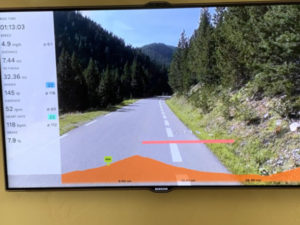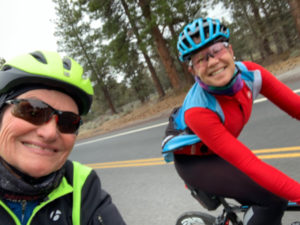.
Anne’s husband Tim riding his e-assist (Trek Domane +) bike up Skyliners Road in Bend at dusk.
Well, Daylight Saving Time is here, the light is lasting longer, and spring is starting to bloom! Your BRNW tour is 3-4 months away, and it’s time to really start riding your bike. If you live somewhere where winter won’t go away, you can still do winter sports – but try to get on your bike at least one day a week so you can develop that muscle memory.
But first, if your bike has been sitting in the garage or on an indoor trainer, have a mechanic take a look at it to be sure it’s ready for outside riding. There’s nothing worse than getting out on a great ride and suddenly your cable snaps when you shift.
If you’ve been working on building your base fitness, it’s time to add in some intensity or “intervals.” If not, go back to January and read the previous blogs; you have time to catch up.
Training zones
Let’s talk about getting a bit more specific in your training this month. Consider the concept of “training zones,” which equate to different levels of intensity and effort level. Let’s work with a framework of five different training zones, in order of increased difficulty or effort level:
1. Recovery
2. Endurance
3. Tempo
4. Threshold
5. Maximum
(Here’s a link to a description about each of the training zones and how they were developed. https://www.trainingpeaks.com/blog/power-training-levels/)
 Riding a Wahoo KICKR (virtual trainer) indoors, up a climb in the Alps.
Riding a Wahoo KICKR (virtual trainer) indoors, up a climb in the Alps.
When building your fitness, you don’t want to go from easy to hardest right away, so in our earlier blogs we’ve been working in the Endurance zone (Zone 2), to build a base. Now it’s time to move up to a moderate effort at Zone 3, or Tempo. Tempo effort can be described as the typical intensity of a “spirited” group ride or a briskly moving paceline. It requires concentration to maintain, especially at the upper end of the range. During Tempo efforts your breathing is deeper and more rhythmic, such that you can only talk in single sentences. Recovery from Tempo workouts is harder than Endurance, but you can do consecutive days of Tempo training if you don’t go overly hard and your dietary carbohydrate intake is adequate.
Thinking on an RPE (rate of perceived exertion) scale where 1 is barely moving and 10 is “I’m gonna puke,” Tempo efforts are a 5 or 6.
Tempo intervals to build strength

Photo by Cor van der Waal
Start off with some long Tempo intervals, on a mix of flat and hilly terrain. Try to maintain your 5 to 6 intensity at a constant level for the entire interval – anywhere from 8 to 30 minutes. The length depends on your base training so far this year. For longer events like BRNW tours, we recommend starting with 8-minute intervals and working up to where you can hold a Tempo effort for a 30-minute interval.
Start with one of these intervals, once or twice a week, and work up to three intervals at least once a week after three to four weeks of doing them. When you’re doing multiple intervals, your rest period in between should be 1/3 the time of the interval.
These types of intervals are the best bang for your buck; they don’t tire you out as much as harder-intensity intervals, but they really give you a good training stress to improve your fitness. Be sure to get plenty of carbohydrates during and after these intervals; this will help you both during the interval and recovering afterward.
Meanwhile, continue doing another one to three days of Endurance rides, always increasing your longest ride as we’ve talked about in previous months. You may also want to try doing two long Endurance rides back-to-back, to start preparing for the bike tour.
Ideally you’re still doing some full-body strength work one day a week, and core strength another one or two days a week.

Anne and Beth Ann Orton, a pro cyclist in Bend, getting in some cold miles…
What your training week looks like
If you’re looking for a very high level of fitness, and have time to do it, here’s a sample week with five days of training: Monday, off; Tuesday, Tempo intervals; Wednesday, full-body and core strength, plus an optional easy spin of less than 1 hour after the strength work; Thursday, Tempo intervals or a longer Endurance ride; Friday, off; Saturday and Sunday: long Endurance rides, plus core work one of those days.
If five days of training a week isn’t realistic for you, try to get in 3 or 4 days a week of training, like maybe one day of Tempo intervals, two days of Endurance rides and one day of strength and/or core. You can really do your core workout on any day; you just want to be sure to get it in at some point in the week.
As with any training plan, recovery is key. If you’re not fully recovered, you might get injured or sick – or just not have fun (that’s the point, right?). So if you’re overly tired and you’re having a hard time starting or doing your planned workout, do a recovery day (yoga, walk or an easy spin, with a very low HR) or take another day off. Don’t beat yourself up; let yourself prepare to fight again another day!

Photo by piqsels.com
Nutrition: carbs are not evil!
Now let’s talk a bit about nutrition, on and off the bike. You know you want healthy meals with plenty of whole grains, fruits, vegetables, and healthy protein and fats. But many people fall prey to the “evil carbs” trope; since you’re increasing your training intensity, be sure you’re getting enough carbohydrates.
Before: It can be different for each of us based on how our stomach and the rest of our body reacts, but most people do best when they have a good solid meal (carbohydrates and protein with good fats) up to two hours prior to their workout.
On the bike: For any endurance or recovery workout of less than 45 minutes, you can just drink water. For any workout between 45 and 90 minutes, you should aim to take in at least 30g of carbohydrates, which equals around 120 calories in the form of food (banana, energy bar, etc.) or carbohydrate electrolyte drink.
If you’re riding between 90 minutes and 2.5 hours, up your intake to 30-60g (120-240 calories) of carbs per hour, depending on your body weight and the workout intensity. And for any workout greater than 2.5 hours, aim for 70-90g (210-360 calories) of carbohydrate per hour – again, depending on intensity and body weight. As the intensity increases, you need more carbohydrates and easier-to-digest foods.
After: If you’ve ridden more than an hour or so and/or done strength work, you need a recovery drink or food – anything easy that provides carbs and protein. There’s evidence that a 4:1 carbohydrate-to-protein ratio is the optimal recovery drink. Aim for at least 160-250 calories. Then remember to eat a good healthy meal roughly 2 to 3 hours after your workout. A great reference book for Nutrition and Endurance activities is Monique Ryan’s “Sports Nutrition for Endurance Athletes”: http://moniqueryan.com/media/books/.
So get out there and ride… and have fun! Next month we’ll talk about adding even more intensity – and go into more depth on recovery and how to maximize it.
This was adapted from a previous blog post by retired physician and professional performance trainer Anne Linton, who lives in Bend. If you’re interested in more in-depth coaching or training guidelines, feel free to email or go to her website at Linton Horner Coaching.